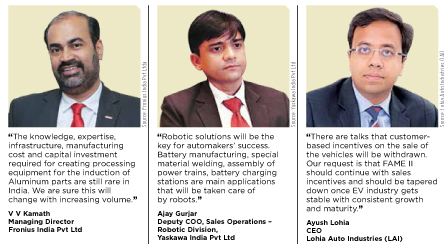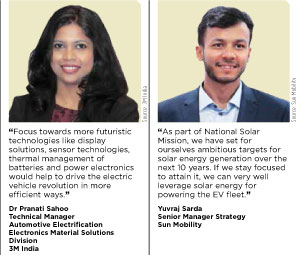A Better Tomorrow

As the country gears up to define its goals for an electric future, industry insiders present their two cents on the advantages that entail this revolutionary shift from traditional gasoline-powered vehicles to electric vehicles, the roadblocks to it, and how the road ahead seems.
That electric vehicles (EVs) are a cleaner alternative to the conventional gasoline ones and have a host of other advantages, including low operating cost, zero tailpipe emissions, low maintenance, high torque power etc, is the awareness that’s seeping in, albeit gradually, among the Indian automobile consumers.
However, as the Indian customers are getting them-selves ready for this shift in mobility and the EV industry is eagerly waiting for the launch of the second phase of the policy on ‘Faster Adoption and Manufacturing of Hybrid and Electric vehicles’ (FAME-II), Prime Minister Narendra Modi has unfortunately indicated a major change in the thrust of the policy, delaying it further.
Raising his concern on the lack of a clear-cut long-term strategy on EVs, Ayush Lohia, CEO, Lohia Auto Industries (LAI), an automobile company that offers traditional as well as green energy mobility solutions, says, “FAME II is delayed and there are talks that customer-based incentives on the sale of the vehicles will be withdrawn. Our request is that FAME II should continue with sales incentives and should be tapered down once EV industry gets stable with consistent growth and maturity.”

Building blocks concerns Battery
Dr Pranati Sahoo, Technical Manager, Automotive Electrification, Electronics Material Solutions Division, 3M India, points to the current EV design in which the Lithium-ion batteries are the single most important component of an electric vehicle, comprising 40 percent of the total production cost. “India imports a majority of its Lithium ion batteries from China, Europe, the US and Japan, which is further assembled by OEMs. The procurement lead time, transportation costs, duty fees and high forex exposure highly affect the final unit price of EVs.”
Seconding Sahoo’s opinion, Ajay Gurjar, Deputy COO, Sales Operations – Robotic Division, Yaskawa India Pvt Ltd, suggests, “Indian Government must focus its efforts to reduce the battery cost with domestic manufacturing and lowered taxes. EVs are more expensive than traditionally propelled vehicles due to high cost of Li-ion batteries, which makes for 40-50 percent of the vehicle cost. Add to that 28 percent GST. EV adoption will be highly dependent on the strategies to reduce battery cost significantly.”
“It is, hence, important to encourage domestic battery manufacturing firms to work on better energy density as well as low cost battery technology. We should have a deep reservoir of technology as well as the capability to address consumers’ concerns for efficiency, power and comprehensive safety,” Dr Sahoo adds.
“Indian R&D efforts on battery raw materials, reusability and energy storage with grids infrastructure is equally challenging for EV segments,” she notes.
“A robust supply ecosystem of charging stations has also remained a key challenge which is creating range anxieties among customers,” she adds further.
Flexible and scalable automation solutions are needed to cope with new and complex processes such as EV battery assembly.
Automation
According to Gurjar, manufacturers can no longer rely on the traditional manufacturing lines to meet the growing demand for EVs. Flexible and scalable automation solutions are needed to cope with new and complex processes such as EV battery assembly. “Since EV is a new market, automakers will encounter a number of issues. Under such circumstances, robotic solutions will be the key for automakers’ success,” he states.
Battery manufacturing, special material welding, assembly of power trains, battery charging stations are main applications that will be taken care of by robots. Yaskawa’s huge product range of arc, spot, handling and paint robots, and recently launched collaborative robots are going to play a key role in EV manufacturing, claims Gurjar.
Lightweighting
“Lightweighting is another key requirement in EV manufacturing as it is directly related to the performance of battery and charge per travel,” points out VV Kamath, Managing Director, Fronius India Pvt Ltd.
Solution to this scenario is using Aluminum, which is already being used by many leading EV manufacturers like Tesla and others in the western countries.
“The knowledge, expertise, infrastructure, manufacturing cost and capital investment required for creating processing equipment for the induction of Aluminum parts are still rare in India. We are sure this will change with increasing volume,” he notes.
Fronius is recognized as a technology leader in welding technology. For several decades, it has been tackling difficulties and successfully made technologies for Aluminum welding. “All leading automotive manufactures like Audi A8, Mercedes AMG and Tesla Electric S Model are welded using Fronius Technology,” he shares.
Power
Another concern is whether our electricity grid can handle the future demand. The coal-fired power again will not end up being environment-friendly. Hence, the answer seems to lie in renewable energy that is wind or solar energy to charge EVs.
“We believe that to create a completely sustainable form of mobility ecosystem, it needs to be electric and powered by renewable energy,” states Yuvraj Sarda, Senior Manager Strategy, Sun Mobility.
“As part of National Solar Mission, we have set for ourselves ambitious targets for solar energy generation over the next 10 years. Due to this, solar energy generation today costs (` ~ 2.4/kWh). It has become a fraction of what it used to be (` ~ 7.4/kWh) and the trend is expected to continue. If we are on track in achieving our targets, we can very well leverage solar energy for powering the EV fleet,” he observes.
“We expect the Government to create supporting regulatory and pricing framework to enable charging infrastructure operators to wheel renewable energy to power this infrastructure,” adds Sarda.
 Perceiving the way ahead
Perceiving the way ahead
“The current modes of conveyance and infrastructure will not suffice in the coming years to cater to the requirements of over 1.30 billion population. There is an incremented need to prepare for a green future for Indian mobility and reduce dependence on imported crude oil,” notes Gurjar.
Recognizing this aspect, the regime of India, is working towards developing a mobility option which is ‘Shared, Connected and Electric’.
“Taking into account Indian market conditions and infrastructure, it will take a long time for EVs to take over the gasoline engine but with the same kind of Government efforts and approach, it can be the good solution for intercity travel system like city buses, e-autos, e-bikes, delivery vehicles where the travel distance will be within the limit of battery capacity,” he adds.
Dr Sahoo presents her view, “Focus towards more futuristic technologies like display solutions, sensor technologies, thermal management of batteries and power electronics would help to drive the electric vehicle revolution in more efficient ways. For this, all the technology platforms need to be more connected to provide a comprehensive solution basket to achieve these ambitious goals of automated driving.”
“The Government certainly needs the interest and platform for global collaborations, technology and market sharing mechanisms, and economies of scale to enable these requirements. Lastly, it is just not the push from the Government, this vision is also being emphasized by collaborated efforts from material technology focused private firms and research institutes to address the growth with divergence of business models and technologies,” she concludes.
With EVs being more energy efficient than the traditional internal combustion engine-based vehicles, they are slated to be game changers.
Another concern is whether our electricity grid can handle the future demand. The coal-fired power again will not end up being environment- friendly.




 Facebook
Facebook.png) Twitter
Twitter Linkedin
Linkedin Subscribe
Subscribe